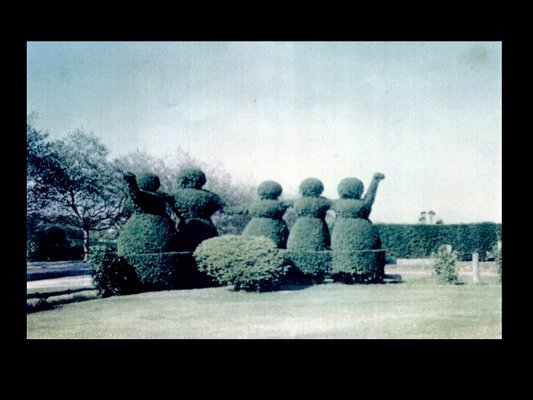
Don’t you just love America? Where else can homeowners create naughty, vainglorious embellishments to their properties long after architects, landscape designers and architectural review boards have moved on to the next project?This type of expression is distinctly American, often perverse, and truly confirms the sovereignty of the individual in a democratic society.
While the Hamptons are often considered a world apart from everywhere else, East Enders still engage in the age-old ritual of keeping up with the Joneses. Here, however, it’s done with small forms of expression. Herb wreaths, ivy kissing balls, live moss letters, topiaries, the ubiquitous American barn star, mind-boggling installations of mulch, and lawn ornaments can run the gamut from the sublime to the ridiculous, to pure kitsch, and total offensiveness.
While many of these things reflect the revolving door of fashion, some of them, like the wildly popular barn star, do, in fact, have symbolic content or purpose. This five-pointed star, seen most often on gables and sidewalls otherwise bereft of decoration, originated in German American farming communities in the 1700s. The raised profile star, made from tin or wood, has also been attributed to the Amish and Mennonite communities as a decoration. In Pennsylvania, however, the star is considered a symbol of good luck. Of course, in Texas it represents the spirit of individualism and the state’s historic quest for independence.
When most people are asked about what the star means they usually say, “I don’t know but I really like it.”
Another disease sweeping the East End in recent years is known as mulchitis. With 60 percent of Long Island covered with grass many view lawns as a prescription for natural disaster. Between the wasteful use of gas for mowers and the polluting runoff from weed-killing fertilizers, many homeowners are intent on ridding their properties of lawn altogether.
Each year they carve away a little more grass and replace it with a veritable lava flow of mulch interspersed with sparse plantings. These weed-impenetrable lagoons very replace front yards on some properties. Volcanic mounds of mulch appear not only around tree trunks but under the entire canopy as well, though this may not necessarily be good for the health of some trees. What’s left is a bizarre landscape of scorched earth and black death.
Whatever happened to good old-fashioned native ground covers? These serial mulchers, who seem obsessive-compulsive, may have some sort of excoriation disorder just like people who pick at scabs. No matter the reasons,, they are changing the landscape in a way that is becoming quite pronounced.
The idea of sculpting with foliage has been around forever and certain shrubs like Buxus sempervirens, aka boxwood, have been used for both hedges and topiaries. A very delightful and humorous topiary once graced Coxwould, the home of the Erdmann family, in East Hampton. Located right on Lily Pond Lane facing the street, it represented five members of the family holding hands.
The flip side of the topiary can be seen, unfortunately, in the use of boxwood as a perimeter planting carved into a series of meatballs against foundation walls all over the Hamptons.
The little lawn jockey, quite an insult to black people today, is an ornament in the form of a statue of a small black boy holding a lantern or a metal ring. The legend of the lawn jockey relates to the story of Jocko Graves, an African-American boy who served under George Washington when he crossed the Delaware to attack the British in Trenton. Considering him too young to come along, Washington ordered him to remain behind and keep his light on to guide the soldiers’ return. The boy, who remained at his post, froze to death during the night with the lantern in his hand. So touched by this boy’s devotion, Washington had a statue cast of him with the lantern and called it “The Faithful Groomsman.” It was supposedly put on his estate at Mount Vernon.
According to Ellen McCallister Clark, the librarian at Mount Vernon, no records of the statue or the story actually exist. The statue today is seen as a commentary on racism in America. Present-day statues of this type have their faces painted white.
While what we do with our properties can be a lot of fun, these expressions are also a form of public art and, in some cases, both knowing and unwitting statements on contemporary culture—certainly something that gives pause to reflect on our freedom of expression.